Mga Pang-uri
Written by Amy C. Peria and Precious Arao
Background
This presentation is prepared for high school students, but can be modified for college students. In this lesson, you will be able to:
- Define types of adjectives in Filipino (ma- or simple adjectives).
- Describe nouns using adjectives (e.g., upuan: malaki – chair: big).
- Use linkers to create an adjectival phrase in Filipino (e.g., malaking upuan – big chair).
- Use two or more adjectives to create an adjectival phrase in Filipino (e.g., dilaw na malaking upuan – yellow big chair).
Motivating Activity
This activity will help you practice colors and introduce you to Filipino linkers (-ing, na, and -g).
Activity 1: Paboritong Kulay (Favorite Color)
Let’s start by discussing your favorite colors.
- Ask students: Ano pa ang paborito mong kulay? (What is your favorite color?)
- Think on your own first. You may have favorite colors that are not on this list.
- Fill-in-the-blank Answer Key:
__________ ang paborito kong kulay.
(color) is my favorite color.
Color List:
- Pula (Red)
- Luntina/Berde (Green)
- Kahel (Orange)
- Dilaw (Yellow)
- Lila (Purple)
- Puti (White)
- Itim (Black)
- Brown








Then, share your favorite color in Filipino with a partner. You may also participate in a class survey to see which one is the class’ favorite color (e.g., using Mentimeter or other online classroom survey tools).
Activity 2: Paboritong Bagay (Favorite Thing)
Now, let’s describe your favorite things using colors.
- Ask students:
- Ano naman ang paborito mong bagay? (What is your favorite thing?)
- Anong kulay ito? (What is its color?)
Example:
Favorite thing – coffee = kape
What color? – Black = itim
Kape ang paborito kong bagay. Itim ang kape.
After figuring out how to state your favorite color in your own sentence, do a tag-speaking activity:
Say what your favorite thing is with the color in a Filipino sentence.
Tag someone in class:
Ikaw ____, ano ang paborito mong bagay? (You _____, what is your favorite thing?)
Processing Activity: Understanding Adjectives (Mga Pang-uri)
This section will provide a lesson on Filipino adjectives and how to use them to describe people and objects.
Types of Adjectives in Filipino
There are two main types of adjectives in Filipino:
1. Ma- Adjectives:
Ma- + root word
- ma + ganda = maganda (beautiful)
- ma + laki = malaki (big/large)
- ma + liit = maliit (small)
2. Simple Adjectives:
- pangit (ugly)
- bata (young)
- duwag (coward)
Adjectives Describing People
Here are some common adjectives used to describe people:
- bata – young
- bobo – stupid (use sparingly)
- duwag – coward
- kuripot – stingy
- salbahe – mischievous
- guwapo – handsome
- pangit – ugly
- tamad – lazy
- matanda – old
- matalino – smart
- matapang – brave
- mabait – good; kind
- malakas – strong
- mahina – weak
- masipag – hardworking
- mataba – fat
- mayaman – rich
- mahirap – poor
- masaya – happy
- malungkot – sad
- matangkad – tall
Activity 3: Describing Self and Others
Review (or introduce) the subject set pronouns (aka ANG pronouns). Here is the chart for the complete set of Filipino pronouns.
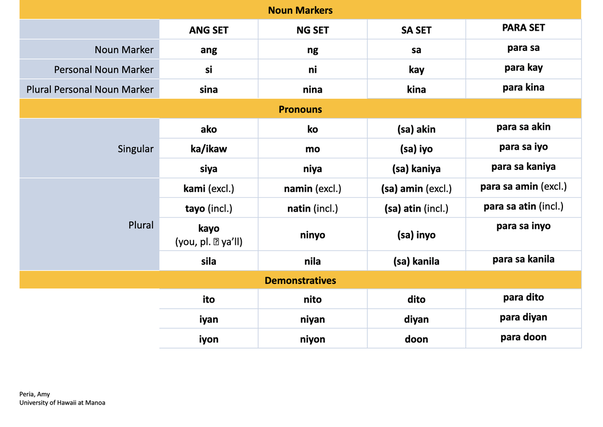
Then, describe 1) yourselves, 2) a friend, and 3) a family member using the adjectives above. Share out loud or with a partner.
For Self:
ako. (adj) Example: Masaya ako.
at __________ ako. (adj and adj) Example: Matapang at masipag ako.
_________ ako pero _________ naman. (adj but adj) Example: Malungkot ako pero mayaman naman.
For Family and Friends:
Description + Person
______ si [name]. / … ang __________ ko. (adj) (relationship) Example: Masaya si Bob. / Maganda ang kaibigan ko. / Mayaman ang tito ko.
______ at ______ PERSON / … ang ______ ko. (adj and adj) Example: Matapang at masipag si Jane.
_________ PERSON pero _________ naman. (adj but adj) Example: Malungkot ang tita ko pero mayaman naman.
Adjectives Describing Objects and Linkers
After practicing with adjectives describing people, let’s learn how to describe objects and use linkers to connect them.
Adjectives Describing Objects
- bago – new
- luma – old
- malaki – big
- maliit – small
- mataas – tall; high
- mababa – short/low
- mahaba – long
- maiksi – short
- mahal – expensive
- mura – cheap
- maluwang – wide/loose
- makipot – narrow
- masikip – tight
- magaan – light
Understanding Linkers
Linkers are used to connect words, specifically adjectives and nouns (in this case, objects).
- na – adjective ends with a consonant other than N.
- Example: mahal na lamesa (expensive table)
- -ng – adjectives ending with a vowel.
- Example: Malaking upuan (big chair)
- -g – adjectives ending with the letter N.
- Example: Magaang libro (light book)
Adjectives Describing Food
- masarap – delicious
- di- masarap – not delicious
- malinamnam – savory
- matabang – tasteless
- mainit – hot
- matamis – sweet
- maasim – sour
- maalat – salty
- mapait – bitter
- malamig – cold
Adjectives Describing Nature
- mabango – fragrant
- mabaho – ill smelling
- maulan – rainy
- mahangin – windy
- maitim – black/dark
- maputi – white
- malalim – deep
- mababaw – shallow
- malamig – cold
To practice these adjectives, you may do another drill similar to Activity #4.
Examples:
- Masarap na adobo
- Maasim na sinigang
- Mababaw na dagat
- Malamig na panahon (weather)
Activity 4: Practice Linkers with Objects
Connect the following adjectives with the object and describe the photos. Fill in the blanks with the correct Filipino linker (-ng, na, or -g). (Teacher note: include more photos for the students to describe – this is a practice drill.)
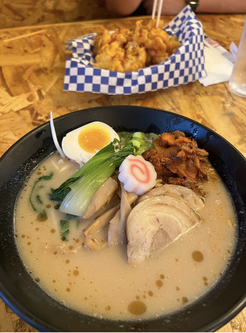
- masarap _____ ramen
- green ___ dahon
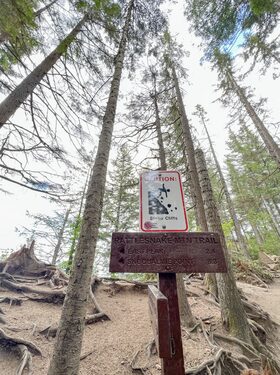
- malaki ___ puno
- mataas ___ puno
- matarik ___ daan
- brown __ sign

- puti ___ snow
- malamig ___ panahon
- berde ___ puno
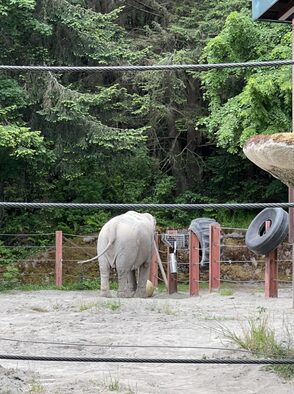
- malaki ___ elepante
- kulay abo ___ elepante
- itim ___ gulong
- pula ___ gate
Two Adjectives in an Adjectival Phrase:
The same rules apply with the linker. The order may be adjective + adjective + noun.
- limang malaking aso
- Maliit na dilaw na libro
- Malamig na masarap na kape
Activity 5: Describe the Classroom
Look around the classroom and describe one thing using two adjectives. Share out loud, ensuring you use the correct linkers between each word.
For example:
- Malaking green na board
- Sirang puting mesa
Culminating Activity: Photo Description
Show photos (feel free to add more) and have students describe them based on what they see or know, using adjectives and nouns.
- First, think of your own adjective + noun combination.
- Second, share it within a small group.
- In each of your small groups, gather all of the descriptions.
- Then, share with the class.
- With the class sharing, each group will have to go up to the board to write their description. They cannot write down descriptions that are similar to the other groups. Each group must share a description. If their description is already up on the board, the group will have to think of something else to share with the class.
Example Photos:
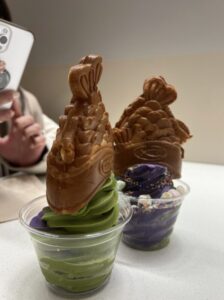

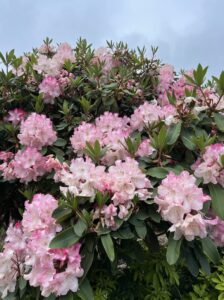
Guide Questions for Description:
Enrichment Activity: “Bring Me” Game
This activity provides an opportunity for students to practice using adjectives in a fun, interactive game.
Activity 7: Bring Me Something
- You will play the “Bring Me Something” game. Here are a few ideas that can be done with the class:
- Asul na bolpen (Blue pen)
- Maliit na eraser (Small eraser)
- Pulang lapis (Red pencil)
- Maluwang na sapatos (Wide shoes)
- Malaking berdeng payong (Big green umbrella)
- Malamig na inumin (Cold drink)
- Asul na pantalon (Blue pants)
- Matamis na kendi (Sweet candy)
- Masipag na estudyante (Hardworking student)
- Pangit na drawing (Ugly drawing)
- You may also ask for 1-2 student volunteers to help you with this game. They can come up with their own adjective + noun combination.